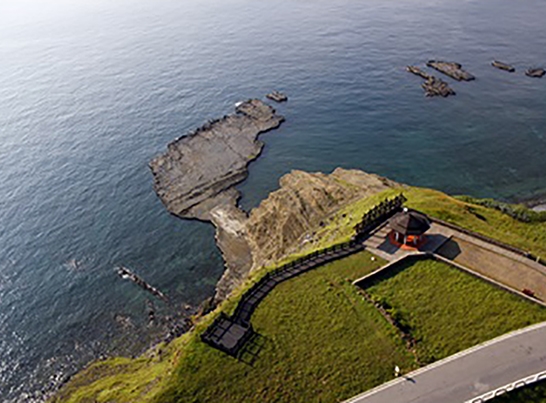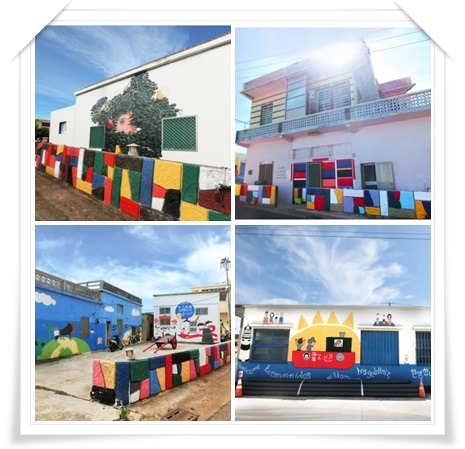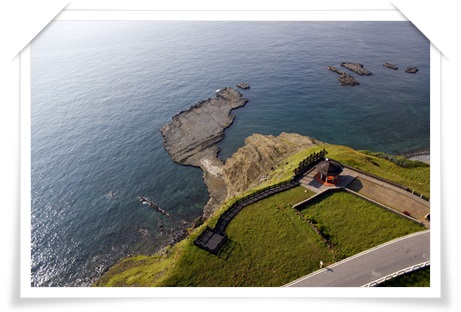Origin of Place Name
During earlier period of Taiwan's recovery, it was called Jhongping Village together with Pinghe Village. Until February 1951, due to local self-government and central location, its name was changed to Jhonghe Village.
Location
It is located on the east side of the central area of Cimei Township. The southeast side is facing the sea, the north is Donghu Village and Sihu Village, the west is Pinghe Village and Haifong Village, and the south is the Harbour Village.
Tourist Attractions
1. Dragon Sea-eroded Platform
Dragon Sea-eroded Platform is composed of three wave-cut platforms. The location of the nearby small wave-cut platforms are like a dragon ball and a dragon head. Looking down from above when the waves dash against the platforms, it is as if the white dragon is roaming on the sea. From the observation deck of Great Stone-Lion Recreation Area, you can see the panoramic view. You can also take the artificial stone path along the coast to the other viewing platform. Follow the slow downhill slope to reach the wave-cut platform, and then you can observe the geological landscape such as chessboard rocks and pot holes. 2. Great Stone-Lion Recreation Area
The joint plane and the cooling isotherm line are vertical, the cooling isotherm line is about parallel to the ground, and the condensation condition is different. Hence, it forms a special form in recent days, and its shape is like a giant crouching lion. 3. Xiaxiang
It is a small bay formed by basalt cliffs. Sea erosion created a strip of path with opening on two ends that looks like an alley. The stone stairway extends all the way to the coast, where wave-cut platforms enclose a portion of the sea into a small bay area. This area is an excellent spot for viewing of the slanting pillar formation of the cap and azure sea. 4. Cheng Village
There is a park celled "Zhongzheng Park" in this historical village. When President Chiang Kai-shek visited the town in 1966, he found that the local residents had difficulty in drinking water. Hence, he instructed the government to drill a deep well and the well was named after his name afterwards.
Food
Dragon Fruit:
Dragon fruit, which belongs to the cactus family, are quite suitable for growing in Penghu. Jhonghe community sorted out the wasteland and started this cultivation. In the past few years, through the rural regeneration courses, the residents have recognized the importance of island ecology development. Therefore, they do not use pesticides and fertilizers to take care of the unique crops.
Origin of Place Name
During earlier period of Taiwan's recovery, it was called Dongsi Village together with Donghu Village. Until 1951, the name was changed to Sihu Village due to its location is on the west of Donghu Village and local self-government.
Location
East is all the way to the Northeast Bay, west is along Sipu, south is facing Shanjiaozai and Tianqian, and north is connected with Northwest Bay.
Tourist Attractions
1. Colored Drawing Art
In 2017, NTU Child of Sea and NTU Art Club together led the way to beautify Sihu community by graffiti. They hope to bring more color and vitality to the community.
2. Prehistoric Stoneware Factory Relics
In 2000 B.C., the prehistoric stoneware relics of Cimei Northwest Bay were exported not only to the southwestern part of Taiwan, but also to Fujian Province. This shows the prosperity of sea trade at that time. Experts and scholars have suggested combining natural basalt landscape with tourism for many years.
Religion
There are two temples in the village, Yulian Temple and Senfa Temple. Yulian temple is the main religion center here, and Guanyin is the consecrating god. A large temple fair will be held every 12 years, and the annual lunar calendar 19th of June is the birthday of Guanyin. Senfa Temple is located at the junction of Donghu Village. The consecrating god is Chenghuang Ye (City God) and its birthday is on 11th May, lunar calendar.
Origin of Place Name
There are 20-30 meter slopelands on north, east and west side, thus forming a southeast small basin which carries rain and becomes a lake.
Location
It is located in the northeastern part of Cimei Island. North and east side are both facing the sea. West side is connected to Sihu Village. The south boundary is at the north slope of the Jhonghe Village north Dongqitou's Huangde Temple. It is the largest among the six villages.
Tourist Attractions
1. Twin-Hearts Stone Weir
It is also known as Diengsi Lake, because it is located at the top of Cimei. There are totals of 700 stone weirs in Penghu, and up to 88 of them are distributed around Jibeiyu. Cimei Twin-Hearts Stone Weir is so well-known not only because its romantic shape but also its good condition. Now only the Twin-Hearts Stone Weir is under annually maintenance. 2. Jinlong Pagoda
It was built on the northeast siding of the mountain in 1952. The purpose of the pagoda was to pray for peace and safety since there were Cholera and several shipwrecks in 1946. Every year on the fifteenth day of the first month in the lunar calendar, worship will be carried out at 8 in the morning. 3. Niumuping
It is located in the boundary between Donghu Village and Jhonghe Village. It is named after the rocky shape of the cow. The name has a very interesting story.
Rumor has it that Cimei Donghu villagers didn't get along well with each other, so fights frequently happened. One day, two villagers decided to battle by riding bulls. The battle lasted for 3 day long and bulls died. Since it was agricultural society, people and cows/bulls had strong relationship. Hence, when the bulls died during the battle, their owners felt so sorry about it and promised no more cows/bulls for battle. They buried the bulls at the beach where the battle happened. After, where the bulls are buried gradually become a huge stone which looks like a bull shape.
4. Little Taiwan
Little Taiwan sits on a wave-cut platform of Cimei east coast. The result of the years of wave erosion. It formed a wave-cut platform shaped like a little Taiwan, so that's why it is called Cimei Little Taiwan.



